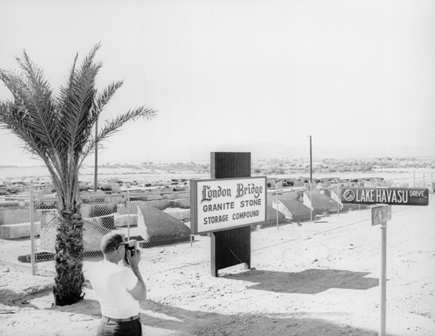
Lake Havasu City would be virtually unknown today if it weren’t for Robert McCulloch. In the early 1960s, the city’s site was a barren World War II auxiliary airfield with no population to speak of. But McCulloch, an industrialist and a developer, thought it was the ideal place to relocate his large chainsaw company while creating a new community in the desert.
About the same time that McCulloch was planning to develop Lake Havasu City, the London Bridge in England was literally sinking into the River Thames. The bridge had been dedicated in 1831 and was in a state of disrepair. Because refurbishment was no longer practical, the City of London decided to auction the bridge to raise funds to build a replacement.
When McCulloch learned that the London Bridge was for sale, he thought of somehow making it the centerpiece of his new development at Lake Havasu City. In 1968, he was successful in his bid to buy the well-known landmark.
In 1969, M. M. Sundt’s heavy civil construction division was already working in the Lake Havasu area on a project to improve Arizona State Route 95, so the company bid on the London Bridge job, and was successful. A new bridge, duplicating the size and shape of the original structure, would soon be built in the Arizona desert. Here’s a look how it happened.
- The five-span reinforced concrete bridge was built entirely on dry land using a technique called soffit fill. Sundt was one of the companies that pioneered soffit fill in the 1960s, a technique frequently used to construct bridges today. In short, soffit fill involves building up a pile of earth so that the mound is as high as the bottom of the bridge to be constructed. Crews form and place a concrete waste slab on top of the mound, and then the entire bridge is built on top of it. When the bridge is finished, the dirt is excavated from beneath the structure.
- The pier-footing design and use of soffit fill were cost-saving proposals Sundt made to McCulloch after the bid.
- Although there were 130,000 tons of granite in the original bridge, McCulloch only bought 10,000 tons of the outer facing blocks. Most were cut down to form a cladding for the new structure.
- When the bridge structure was completed, Sundt received a separate contract to apply the facing stone, which had been match-marked so they could be placed in their original relative locations on the bridge. The stones weighed between 1,000 to 8,000 pounds.
- Sundt was then contracted to build the one-mile-long channel that cuts across the peninsula to place a watercourse under the bridge.
In 1971, The New London Bridge and an adjacent English Village were dedicated with the Lord Mayor of London in attendance. The ceremony, which closely matched the decor and menu of the original 1831 dedication, attracted 50,000 spectators. Time has shown that McCulloch’s vision for the London Bridge attraction in Arizona was correct. Today, Lake Havasu City draws more than one million visitors annually, and the London Bridge – which celebrates four decades in the Grand Canyon State this year – is considered by many to be one of the seven wonders of Arizona. Sundt is a proud sponsor of the bridge’s 40th anniversary rededication event happening today, Oct. 14. To learn more about London Bridge Days festivities (underway now), visit the Lake Havasu CVB website.